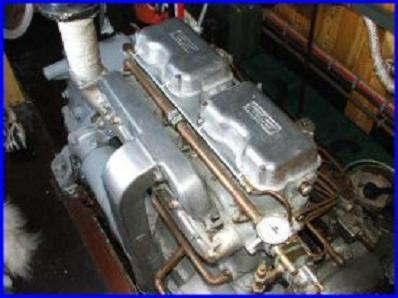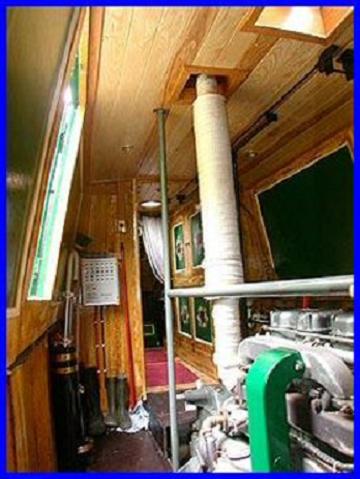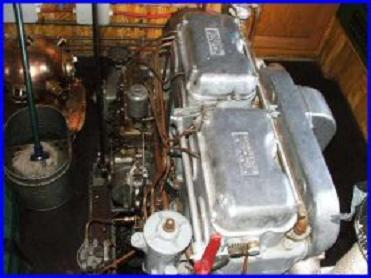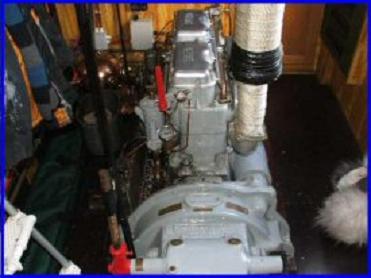Lionheart's Engine
Absolutely nothing to do with electronics or electrical systems on this page. Nothing whatsoever. No attempts to sell you anything and no attempts to educate anyone or convert them to our way of thinking. In fact, many of you probably know far more about these engines than I do. Which, in all honestly, wouldn't be at all difficult. But my lack of knowledge on these engines doesn't stop me loving them.
Whilst I am all for technology where it's needed, and could be considered a bit of a technology geek, I do so love an honest to goodness old diesel engine.
Lionheart is fitted with a Gardner 4LW which, to be frank, was a complete mess when I bought her.
Here's a kind of "before and after" pair of photos. I hope you can tell which is which.
|
|
|

I think it looks quite respectable now.
It's certainly a vast improvement.
Notice all the bare aluminium. The idea is to get
all this polished..... one day.
|
|
Here's a couple more for the anoraks.
Now if you look in the top left corner of the two bottom photos you'll spot a great big copper and brass thing. I'm sure you can see that it's actually a "hard hat" diving helmet.
There's a story and a moral behind this. The story is boring. The moral is, "don't go on ebay when you're drunk"
This engine has cost a lot of time and money. Everything I did to it seemed to cost £200 plus 3 days of my own time.
Some heathen had put an electric fuel lift pump on it. I replaced that with the proper one. £200 plus 3 days fitting, re-arranging the pipework and moving the first fuel filter and water trap.
It had manual engine temperature control due to the fact that it was built as a genuine marine engine with raw water cooling.
Manual temperature control is a real pain so I built an automatic one (not easy with a ram type water pump - they tend to destroy the thermostat). £5 for a Ford Fiesta thermostat housing from the breakers yard, then, you guessed it, £200 to have the rest of the bits made. Followed by 3 days fitting and messing around with pipes, tweaking and getting it to work properly.
And work properly it has. Holding the temperature within a sensible range at tickover or when running hard against the flow. Worked like a dream for over 1000 hours now.
The water header tank was a square steel thing. 'orrible it was. I had a brass cylindrical one made. Yup, £200 please. Again, 3 days work. But this time it was a morning fitting the thing and re-arranging the pipework, followed by 2 1/2 days soldering up all the leaks in the newly made water tank! (at the time it seemed easier than taking it back to the bloke who made it).
The head gaskets leaked oil (not blowing, just oil leaks). I had them replaced, £200 please. Not 3 days this time, but one day, as I helped him ("pass me that spanner" - but I do think it was a bargain to be honest).
The water pump started to leak. Very hard to get hold of and very expensive, so I had it re-engineered. Sleeved and rebored, new rubbers etc, £200 please. 3 days removing, refitting, driving round there etc.
Must be a nice round number.
Anyway, the 30 coats of paint were removed, it was repainted, along with the gearbox (all in the wrong colours I might add) and as much of the modern "mess" as possible was removed and replaced with original. I painted the crank-case silver, everything else grey, and anything that moves red - this is mainly so I can say to the kids: "if it's red, don't touch it" (I make the [perhaps foolish] assumption that they know not to touch the flywheel). You can see the decompression lever and gear selector in the photos - there are also a few bypass valves for the cooling system and calorifier which, if put in the wrong position, cause excess pressure, due to the pump being a ram type, which wrecks the thermostat. Some aluminium parts are bare metal.
A few of the aluminium parts were even polished. Some still need to be done having only got as far as sanding them to a matt finish.
I counted 39 separate oil leaks on it. Apparently that's normal for a Gardner. They were built almost entirely without gaskets (on some of them the head gasket is a piece of steel!). I have managed to reduce this to 3 now. Which, again apparently, is quite remarkable for one of these engines.
2 of these are quite easy to fix but I just haven't had the time to get round to them yet. The other one is a bit more tricky. I'll get it done one day.
Addendum: Today I found 2 more oil leaks, but only minor ones.
I'd like a green engine. But that's just wrong on a Gardner. Anyone got an old Lister or RN for sale?
Web site and all contents Copyright SmartGauge Electronics 2005, 2006, 2007, 2008. All rights reserved.
Page last updated 02/04/2008.
Website best viewed on a computer of some sort.



